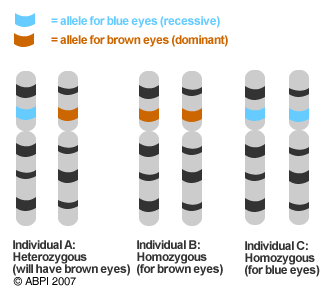Genes and DNA
Where are the genes?
Most cells in the human body have a nucleus containing 23 pairs of chromosomes. A small section of a chromosome that controls one particular character, e.g. eye colour, is called a gene and each chromosome carries hundreds of genes. Scientists have identified all the human genes and the complete set, of 20,000-25,000, is known as the human genome. Only some of the full set of genes is used in any one cell - some genes are "switched off".
Chromosomes
Chromosomes are made from very long molecules of DNA. Each molecule is in a ladder-like shape, with the "rungs" being made from a pair of nitrogenous bases, known as A, T, G and C, and the sides made from repeated pentose sugars and phosphate groups A group of one base, one pentose molecule and one phosphate together is known as a nucleotide and DNA can be regarded as a polymer of these nucleotides.



The bases are always paired A with T and G with C and it is the exact sequence of these base pairs in the DNA molecule that maps out the genetic code of the individual.
The DNA molecule is twisted into a double helix and coiled so tightly, that the total length of the human genome, about 1.8m, fits inside a nucleus of diameter about 6 micrometres.
You are a unable to view this animation as you do not have the correct version of Adobe Flash Player installed. Please visit the Abobe website to install the latest version of the free Adobe Flash Player
Genes and alleles
The chromosomes in a pair carry the same genes at the same positions. One of each pair has come from the mother and the other from the father, so the genes are also in pairs and both code for the same characteristic. These alternative forms of one gene are called alleles

An individual may have two alleles the same or two different alleles for any one gene. For example, there are two alleles of one of the genes controlling eye colour. They may both code for blue eyes or one may code for blue eyes and the other for brown eyes. If both alleles are the same (e.g. both for brown eyes) they are known as homozygous alleles and if they are different they are known as heterozygous When alleles are heterozygous it may be that one of the alleles is dominant and the other recessive. A dominant allele always shows its related characteristic in the individual.
You are a unable to view this animation as you do not have the correct version of Adobe Flash Player installed. Please visit the Abobe website to install the latest version of the free Adobe Flash Player
A gene is a piece of DNA which has the code for a particular protein. Bases in the gene determines the order in which amino acids are put together to make the
protein. Proteins have special functions in the body so it is very important that the correct
proteins are made. Occasionally there is a change in the order of the bases so the correct
protein cannot be made and the cell cannot function properly. Such a change is known as a mutation.
Read more about mutations in What Can Go Wrong.
You are a unable to view this animation as you do not have the correct version of Adobe Flash Player installed. Please visit the Abobe website to install the latest version of the free Adobe Flash Player
Question 1





















